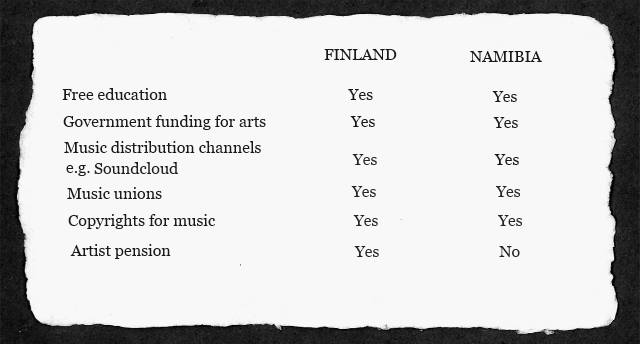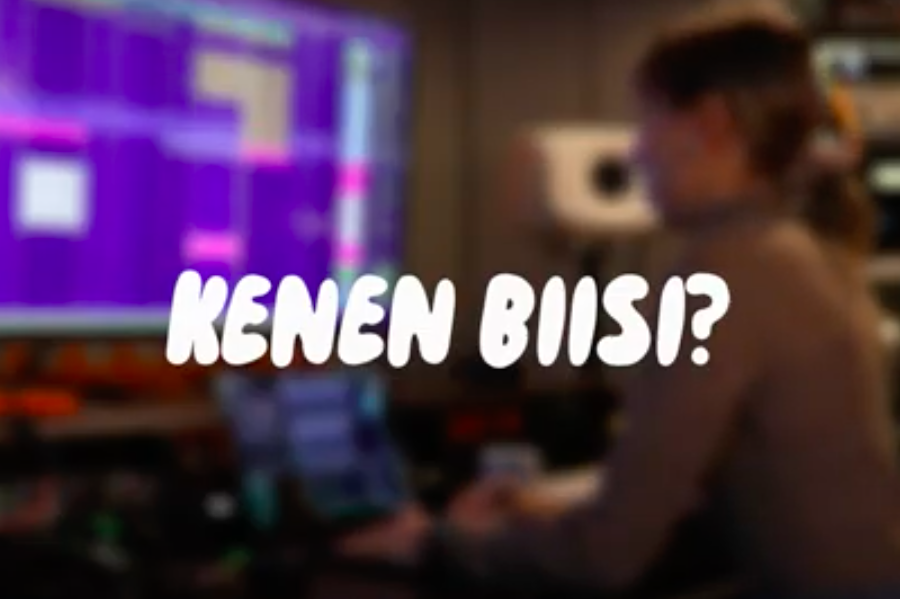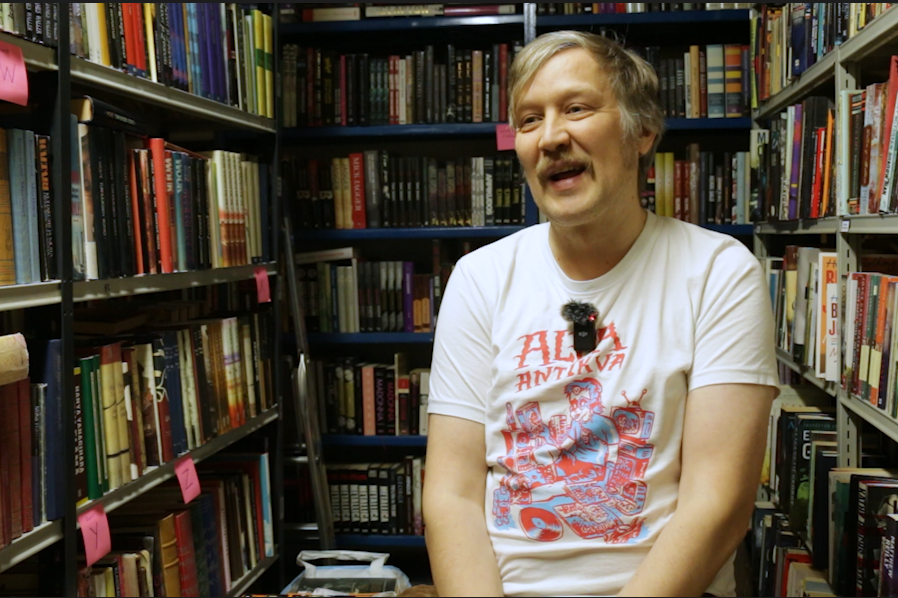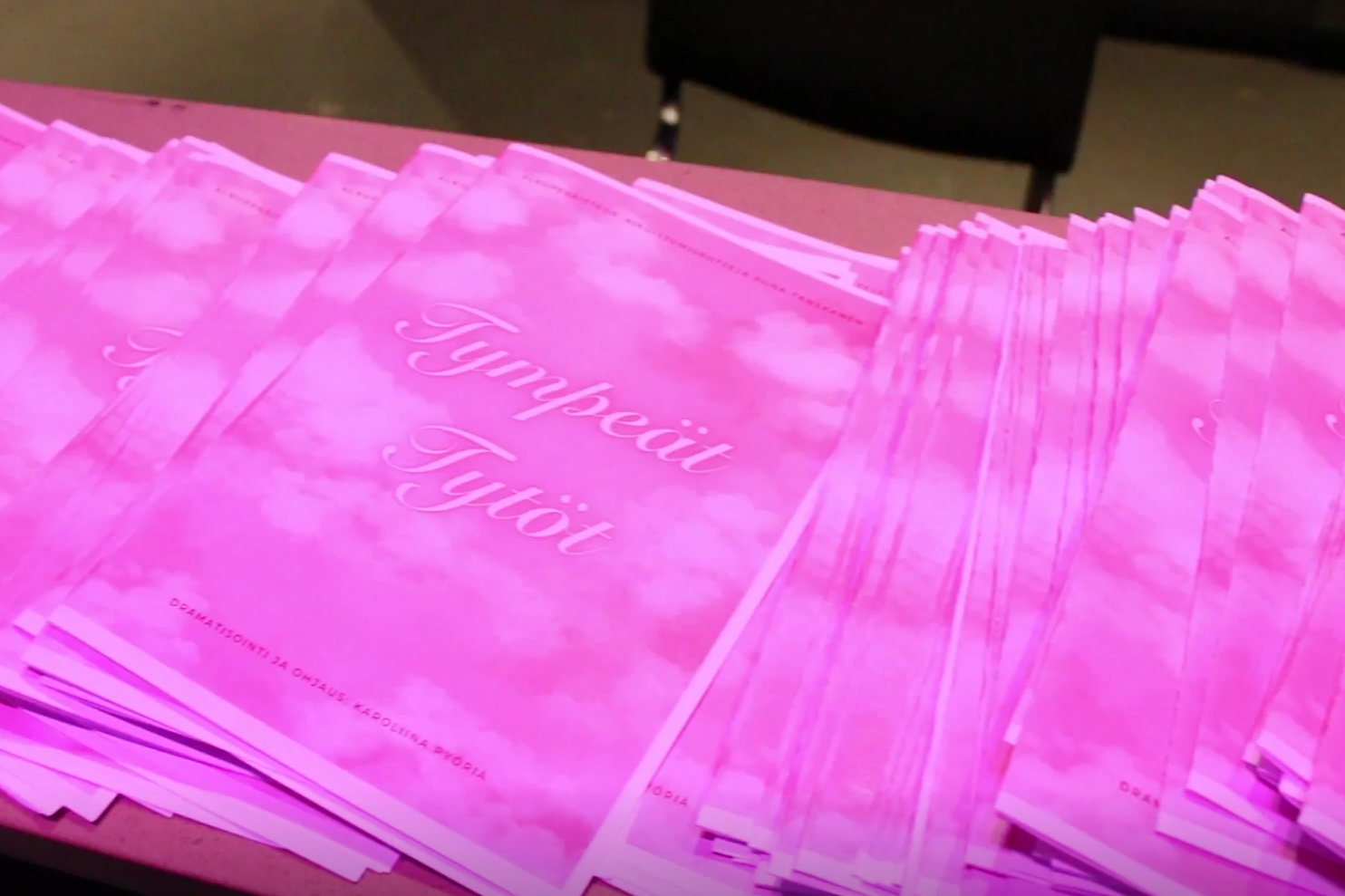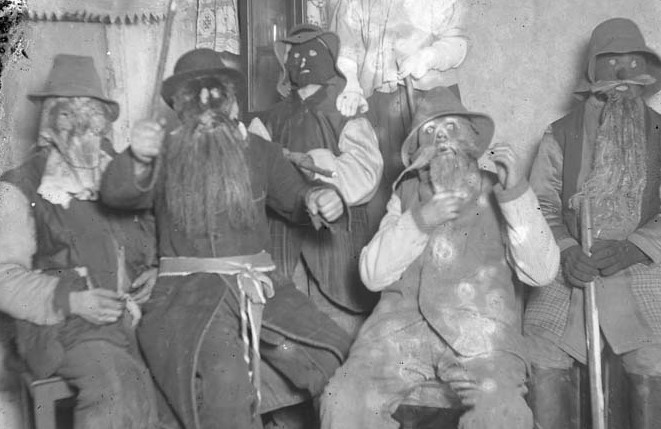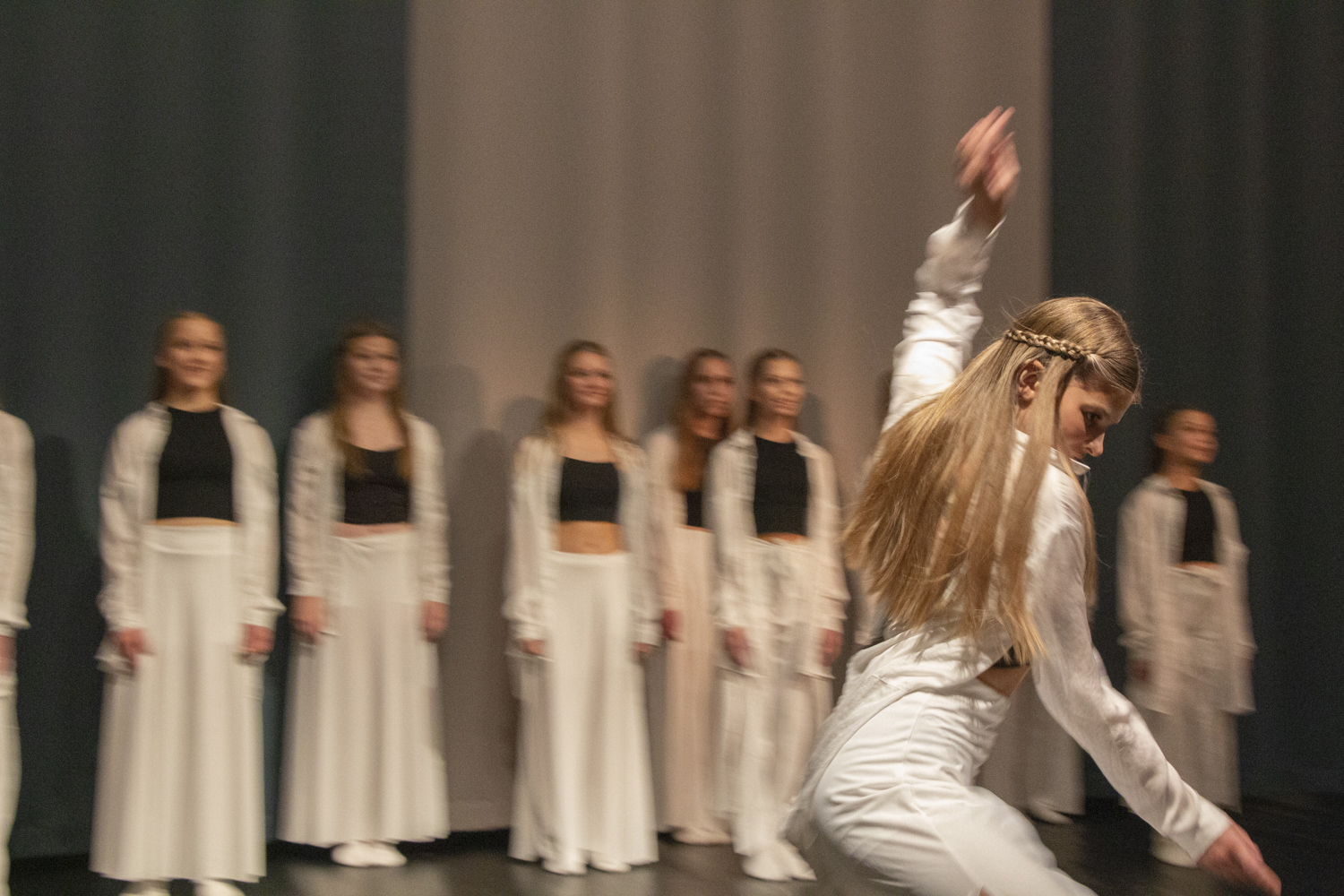
[metaslider id=6531]
We all want to make a living out of what we love to do. But sometimes it is not possible. The music industry is known to be one of the toughest businesses in the world. Still millions of hopeful people are trying to make it as a musician.
Everyone dreaming of becoming a professional artist should have an equal opportunity to achieve their dreams. The treatment and possibilities of musicians vary from country to country. Sometimes musicians are not treated or paid fairly.
This report compares the situation in Finland and in Namibia. These two countries vary in regards to musicians’ rights, payment and funding. What has been done right in Finland? What could Namibia learn from Finland’s triumphs and mistakes? What are the challenges in both countries?
Playshis the poet is an upcoming artist from Namibia. When asked if he feels he can freely express himself without manipulation, he states ‘yes’, due to civil society organizations that promote and protect his rights, while he respectfully honours the rights of others in his work.
[metaslider id=6563]
[soundcloud url=”https://api.soundcloud.com/tracks/139378930″ params=”color=ff5500&auto_play=false&hide_related=false&show_artwork=true” width=”100%” height=”166″ iframe=”true” /]
Just to get a clear idea of how different the situations are in Finland and in Namibia let’s look at some facts of the countries.
In Finland copyright to one’s written or artistic work is a statutory right. It is written in Finnish law and the Ministry of Education and Culture is responsible of controlling and improving it. At the moment the copyright law can leave an artist very alone and being the underdog in contract negotiations. The law is currently under deliberation in the Ministry of Education and Culture.
The Namibian Government has a department of Youth, National Services, Sport and Culture. But there is no specific information about how they support any form of arts. There isn’t any readily available web based information easily accessible, giving any evidence about implemented policies, funding towards music organizations or musicians. Luckily, the copyright system is acknowledged and so the musicians do own the rights of their musical work.
”Money, money, money must be funny in the rich man’s world”
Finnish artists have a possibility to apply for Artist’s pension which is written in law. Artist can receive a full pension or partial pension. This pension is granted by the Ministry of Education and Culture.
In Finland there are many options where an artist can apply for a grant or funding to their music career. An artist can find funding from a churches, municipalities, schools, companies or even private persons. Some of the biggest unions which give grants are for example Suomen Kulttuurirahasto (Finnish Cultural Foundation), Musiikin edistämissäätiö MES (The Finnish Music Foundation) and Taiteen edistämiskeskus (Arts Promotion Centre Finland). Taiteen edistämiskeskus is part of of Finnish Ministry of Education and Culture.
Teosto and Gramex are Finland´s largest copyright organizations. Each author gets an average of 486 euros annually throughout these systems. Money shared regarding on the artists role and of success, of course. Almost all the funds (90%), Gramex and Teosto raises, goes back to music culture.
[metaslider id=6556]
Musicians in Namibia can apply for a membership to a couple of music unions. The Namibian Society of Composer and Authors of Music (NASCAM) protects the works and rights of their members. They collect royalties and fees from those using the music in public places.
The National Art Council of Namibia is another union. But as the name predicts, it doesn’t focus on just music, but on the rights of artists in general.
Most of Namibian musicians however do not agree with the policies and the working force of the unions. This was discovered during a collective meeting whereby local musicians joined to air their voices, in November 2013, against I’ll treatment. Kelvin Kamalata, a professional Namibian musician, says that Namibia Music Industry Union and Oruuano are “toothless and they need to define their purpose”. NASCAM faces charges of corruption as artists wait for outstanding royalties.
On the development aspect of this country, The Namibia Music Awards – NAMA’s – an annual event, can be seen as a growth in the industry as Artists have the platform to be recognized and rewarded for their work. The organisers aim to expose their winning applicants to the global industry giving them prize money, possibility of record lable signings sponsorship for international tours.
Ilari Oinonen, the singer of upcoming band Malestain, talks about the challenges as starting band in Finland.
[metaslider id=6564]
[soundcloud url=”https://api.soundcloud.com/tracks/139363172″ params=”color=ff5500&auto_play=false&hide_related=false&show_artwork=true” width=”100%” height=”166″ iframe=”true” /]
New media – new problems?
New streaming services, like Spotify, have brought some challenges to otherwise well developed music industry in Finland. Pekka Gronow, the adjunct professor of ethnomusicology at the University of Helsinki, says that as these international services grow the position of Finnish artists may weaken.
”The streaming services discuss the compensations they pay with the big record companies on an international level. The artists get the same percentage of the streamings as they get of the record sale so everything depends on the original recording contract. Finnish artists don’t stand much of a chance to affect this afterwards.”
”At the moment though these services are still small compared to the Gramex and Teosto compensations the radio stations are paying”, Gronow adds.
According to the internet world statistics (2012), 12,9 % of Namibians use the internet, while 91 % of the Finnish population use theirs. The interviewed artists from Namibia both use the internet cloud, facebook and twitter to promote their work. But compared to Finland, Spotify for example is too costly for those 12,9% using the internet.
[metaslider id=6568]
Development is not only doozy
The big change in Finnish music industry doesn’t only mean challenges but also development. Ahti Vänttinen, the president of Finnish Musician’s Union says that today the artists can communicate with their audience directly, without ”middlemen”.
“Many artists who haven’t had enough audience in Finland can now serve a global audience which may consist of individuals from all around the world.”
There will be development in the artist’s rights too in the future. It’s been promised in the government program that copyright law will be more exact so that the copyright contracts would become more reasonable for the artists.
“The culture minister Paavo Arhinmäki tries to fix this during this period of rule. Finland needs the creative class more than before so with these laws we make sure that we have as good circumstances as possible for the creative work”, Vänttinen reminds.
In Namibia there are 11 different ethnic groups. Promotion of arts and culture improves dialogue among people with different ethnic and socio-economic backgrounds. Culture also contributes to economic growth and job creation. It improves quality education and citizenship building. It’s a source of gender empowerment, crucial in Namibia where Gender Based Violence is a big problem. It plays an important role in developing a sustainable and happier society.
Namibia can learn from the Finnish music institutions to provide transparent information about music funding, statistics and artist’s rights. Musicians from all over the country should get equal opportunities. Music organizations should pay the artists on time and should give honest information. In short, they need to put their constitution in action.
Congratulations if you made it this far. We are going to dig deep now so keep calm and carry on!
Finnish education, copyrights and other systems are made to protect artist´s work and shape the level of author’s expertise. Thanks to all to these different channels artists have a possibility to make music tomorrow as well. Finnish law provides artist possibility to receive salary for his work.
Compared to Namibia Finland is a way ahead on these levels. In order to develop Namibia further they should find a solution how to progress their policies regarding musicians’ rights.
Finland needs to go further in their ICT policies that artists can make more income through programs like Sound Cloud and Spotify, while Namibia drastically needs to improve ICT access for its people to perform at the same level as the rest of the world.
Art and culture’s economic role in no way undermines its value. Culture has a huge potential for growth and jobs.
This article was produced as international team work during “Newswriting – Focus on Development Journalism” –course in TUAS. The participants came from Ghana, Namibia, Tanzania, Netherlands, Belgium and Finland. The course was taught by Ms. Bertha Amakali, Deputy Head of Department from Polytechnic of Namibia, Mr. Geofrey Aloyce, Head of Journalism Department from University of Iringa and Mr. Kodwo Boateng, Acting Dean from Ghana Institute of Journalism.
The course was supported by JOCID project (Journalism for Civic Involvement, Democracy and Development).
Tuoreimmat
-
Maskin takana
-
Aaron Charles joutui kokemaan räikeää rasismia kotimatkalla
-
”Ihmiset ovat parasta, mitä olen juoksukerhoista saanut” – Yhteislenkit vetävät mukaan erityisesti nuoria aikuisia
-
Hyrox houkuttelee yhä useampia – laji on suunnattu kaikentasoisille
-
Sovituksesta suureen päätökseen: näin morsian löytää pukunsa
-
Auto ei enää päädy murskaksi – EU:n kiertotalouslinjaus muuttaa purkutyön
-
Sopivia vanhemmiksi – Hilda ja Mira pelkäsivät pitkään, että pääsy hedelmöityshoitoihin evätään heiltä
-
FCAA-lopputurnauksessa syntyy enemmän kuin voittajia – opiskelijat rakentavat yhteisöä ja hyvinvointia
-
Kenen biisi?
-
Syksyllä järjestetään jälleen vaalit: tällä kertaa ne koskevat korkeakouluopiskelijoita

